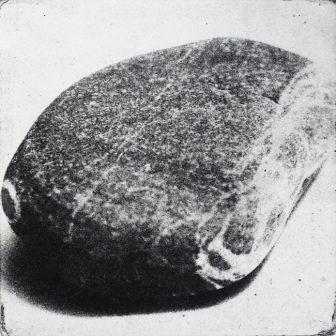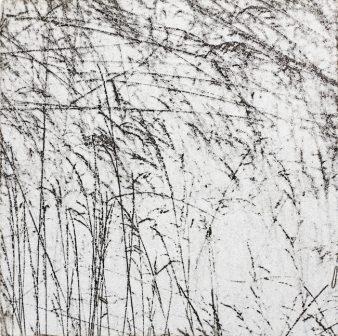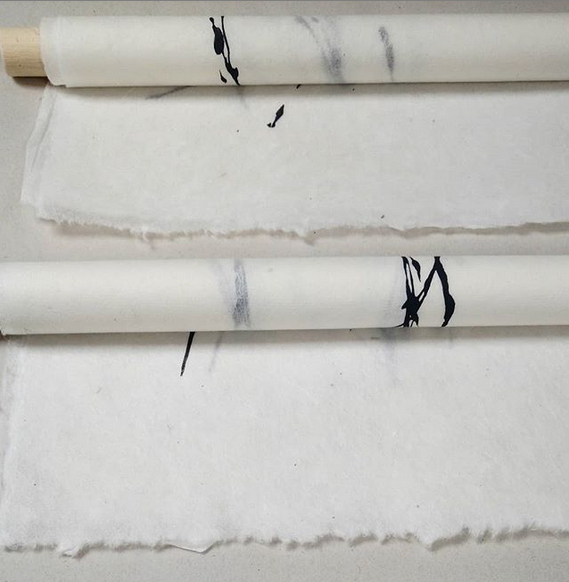How could one translate silence into imagery? We all might have an initial idea of what a “loud” image is: something with exaggerated bright colours maybe, “screaming” at the viewer. But what is it that makes a picture silent? And how do you depict silence?
Sarah Roach is a photographer and printmaker from Nottingham exploring silence in her work. Her minimalistic, often black and white prints combine crisp edges that stem from exaggerated contrast in photography with softening elements like blurring, layering or printing on a textured substrate. Her topics come from details found in nature: silhouettes of grass or trees against the sky, or the shoreline rendered black between the white sand and blazing sky. Some are almost unbearably harsh in their contrast, others are smoothened out by bluriness or layering effects similar to multiple exposure photography.
To me they not only speak of silence, but also of loneliness, of longing for the long summers spent lying in the grass as a kid, of a longing for simplicity and calmess.
Hilke: Hello Sarah, thanks for welcoming me in your studio today! Let’s start with some basic questions first: How would you say you became an artist?
Sarah: I don’t remember to ever consciously make a decision to be an artist. I always enjoyed art and the process of thinking about things, having ideas and creating but I was never your traditional artist. I was about 15 when I realised I wanted to study art. I started as a painter but it was never just straight painting with me, there was always another dimension to it. And even while I was painting I also made things.
You mean like taking photos?
The photography came much later. After my fine art degree, around 1999, I was living in very small rented accommodation. I was working full time then, but to keep my creative side happy I did a photography course as I thought it was a way of being creative that didn’t take up much room.
Was that when you started your current practise?
For a while I took photos but didn’t really do anything with them. It was my partner who made me realise I should do more with my photography and with my creative side. He told me it made me happy – it’s funny how sometimes you don’t realise that by not doing something you’re making yourself unhappy, until it’s pointed out to you.
Quite a few years later I had the opportunity to study for my Masters while working part time. It was then that I started with printmaking, and developed my current style of work.
On your website you call yourself a “photographer and printmaker”, and you also bind some of your works into books. All three of them, photography, printmaking, and bookbinding have this craft-aspect to them and can be very technical. How do you see this navigation between art and craft?
I don’t see a dividing line there. To me it’s all part of the same thing – a way to express ideas and be creative. It doesn’t necessarily need to be defined as anything other than art.
The dividing aspect that is important to me and my practise is how abstract a process is, how removed you are from your subject matter.
I mentioned before already when I was a painter there was always another aspect to my work. I like to do things with my hands and I like to make things. With photography (especially with digital photography) I often felt a bit removed from the subject and ideas, and once you had printed the photograph that was it. I always felt slightly dissatisfied with that.
That’s where it becomes important to me to develop my photos further, and add a more hands-on process to it. I work with photographic etching, and the making of the plates and the printing of the images is very close to working with analogue film, but you get the added loveliness of the textures, the ink, and the edges created by the plate. You get inky hands, the whole of you becomes part of the work.
The techniques I use in printmaking make me look at photography differently and it helps me experiment more – they feed into each other, which makes me think beyond the photographic image – the photograph almost becomes just a step in a journey.
The book making really came about through my love for books and paper. Binding semi-transparent pages with my prints allows me to build up a work through means of layering. There are several aspects to this that I like: the building up of an image, but also the blurring and softening that comes from not looking at one print directly but through additional layers of paper. I screenprint on thin paper, too, and often I like the backside of my prints better than front.
But mostly I like books, and I like my work to have a tactility about it – and what’s more tactile than a book?
I guess that can be seen as related to craft – that you can touch someone’s work.
In your statement you write: “I am fascinated by silence and its relationship with sound and the world around us.” Could you please explain that in more detail? It sounds very poetic, but I don’t really understand it. How do you photograph silence?
I’m naturally a very quiet person and I enjoy time away from a lot of noise. Walking and spending time outside in nature is often where I can experience feelings of calmness and stillness and I think that is what I was always striving for in my images.
So that’s why most of what you photograph is nature?
Yes, I like nature and the landscape, especially grasses and stones, and I photograph what I like. I just love grass. There’s so much variety to it, and it can look like branches and even trees when blown up.
I also like trees, but they are hard to photograph without background, and a discernible background is like adding noise to me.
I sometimes photograph grass in situ. I then use overexposure and play tricks with light to isolate my motif from the background. I also have a collection of dry grass and stones at home that I simply place on a white surface to photograph.
I can perfectly see how a minimalistic image of a single blade of grass or a single pebble is “quiet”, and a bright, colourful painting might be loud. But the tangible connection you seem to feel is remarkable.
Silence is important to me.
It took me a while to realise this, but when I did, it opened up a whole new world to me. I began to read about silence (I know it sounds boring but you wouldn’t believe how fascinating it is) and what I did realise is that you can’t have silence without sound – how would you know what silence was without sound? Then the big thing – that silence doesn’t actually exist.
Sarah picked up a couple of books and told me about them. People who went to the desert in a quest for silence, and – I probably shouldn’t have been surprised – a range of books about music. In the books stuck hundreds of post-its, colour coded, marking passaged to be entered into a database on her computer, so she can quickly find quotes and ideas again that struck her as remarkable.
She told me how we can hear our body when other noises are drowned out, and as a human, apparently you can’t ever experience the total absence of any sound.
We also talked about ambient sound, and how different rooms, landscapes all have their own sound. And how different vegetation generates different sound. Going to the desert to experience sound is not just to escape humans, or other animals, but also to escape the sounds of vegetation.
Did you ever go on such a trip, to the desert or elsewhere to find silence?
No, I’ve never had the opportunity, but I’d like to. I think I would love it, but I have read that some people don’t, it’s too much, that much silence.
Coming back to your art. How does it relate to sound or silence?
In my photographs I am trying to create a visual representation of the space that exists between sound and silence, the moment of stillness, of silence that occurs just before sound.
Do you have plans for future work? Do you have any work in progress you would like to talk about?
I just started printing on a range of different fabrics, and I am playing with the idea of presenting them folded up: In that manner one can see part of it, in a layered block, but a part also remains secret. I find this idea very appealing. But my thought process is not finished yet. I also played with other thoughts of how to layer them. – This might end in a new body of work.
I am looking forward to seeing what will come out of this!
Sarah, thank you so much for having me here today, and for this conversation!
All images of her work are copyrighted by Sarah Roach and were used with her kind permission.







